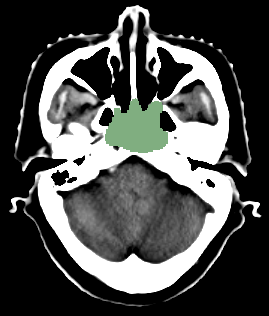Dataset Description¶
We will provide data of two types of cancers, nasopharyngeal cancer and lung cancer, with OAR and GTV annotations.
- Nasopharynx cancer
- Organ-at-risk segmentation from head & neck CT scans.
22 OARs of 50 nasopharynx cancer patients will be annotated and released to public as the training data. Each of the annotated CT scan is marked by one experienced oncologist and verified by another experienced one. Another 10 patients’ CT scans will be used as the test data.
The 22 annotated OARs (with importance weights) include: left eye (100), right eye (100), left lens (50), right lens (50), left optical nerve (80), right optical nerve (80), optical chiasma (50), pituitary (80), brain stem (100), left temporal lobes (80), right temporal lobes (80), spinal cord (100), left parotid gland (50), right parotid gland (50), left inner ear (70), right inner ear (70), left middle ear (70), right middle ear (70), left temporomandibular joint (60), right temporomandibular joint (60), left mandible (100), right mandible (100).



- Gross Target Volume segmentation of nasopharynx cancer.
The 50 GTV annotations of the same 50 nasopharynx cancer patients’ CT scans will be provided as the training data and another 10 patients’ GTV will be used as the test data.



- Lung cancer
- Organ-at-risk segmentation from chest CT scans.
6 OARs of 50 lung cancer patients will be annotated and released to
public as the training data. Another 10 patients’ CT scans will be used
as the test data. Each CT scan is annotated by one experienced
oncologist and verified by another one.
The 6 annotated OARs (with importance weights) include: left lung (100),
right lung (100), spinal cord (100), esophagus (70), heart (100),
trachea (80).


- Gross Target Volume segmentation of lung cancer.
The 50 GTV annotations of the same 50 lung cancer patients’ CT scans will be provided as the training data and another 10 patients’ GTV will be used as the test data. Each CT scan is annotated by one experienced oncologist and verified by another one.


